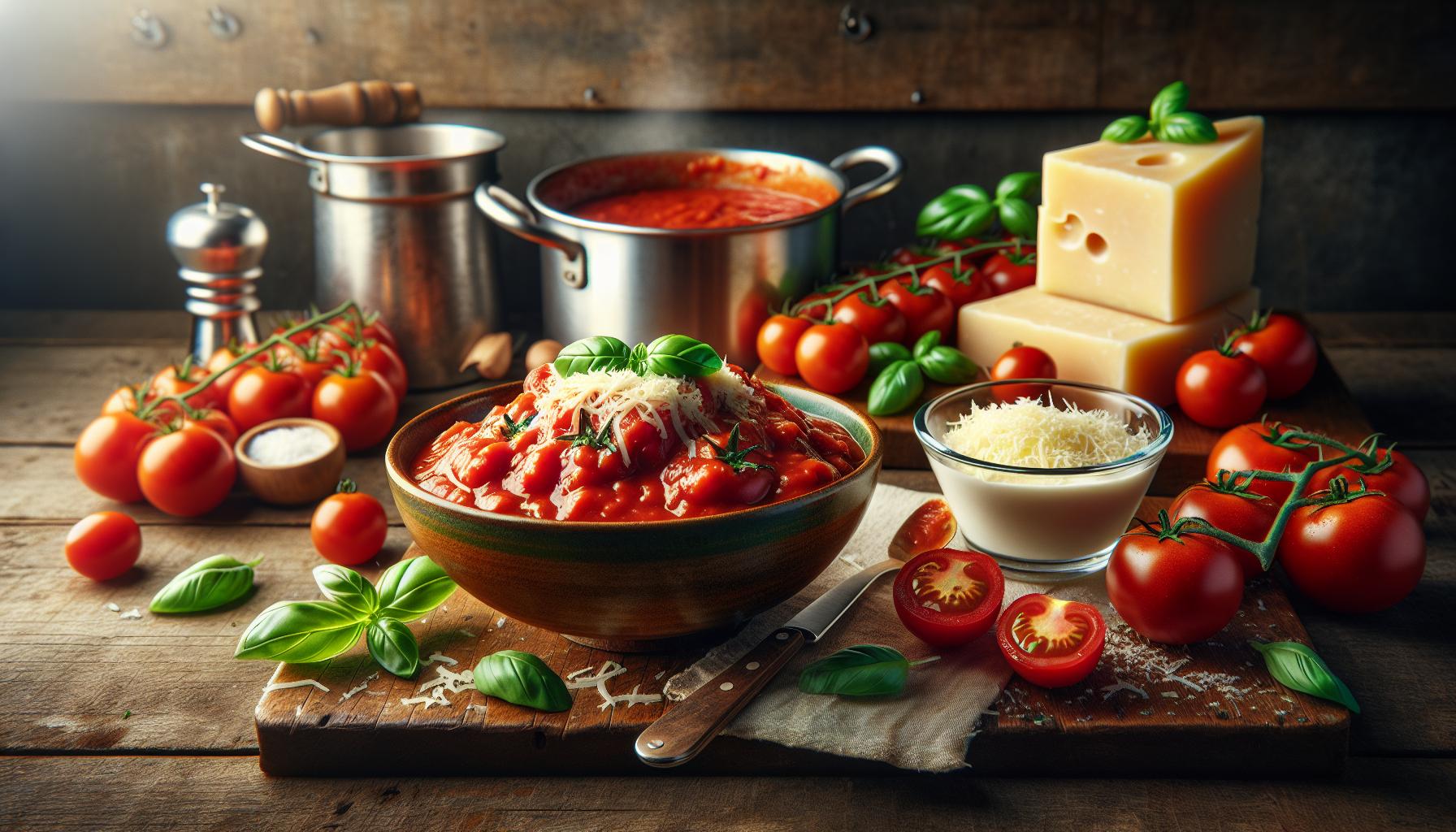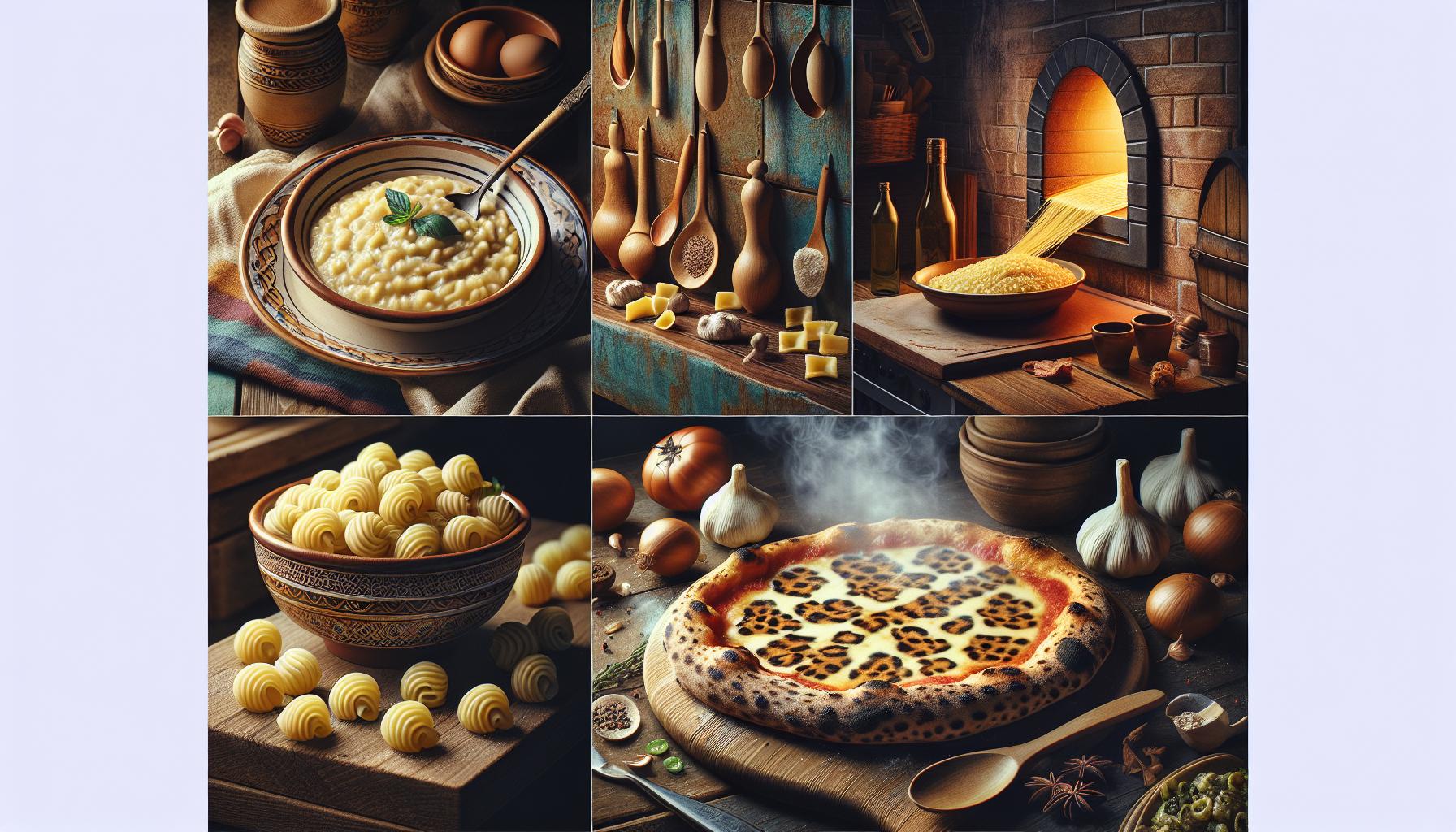Italian Cooking Techniques has captured hearts worldwide with its time-honored cooking techniques that transform simple ingredients into culinary masterpieces. From the art of making fresh pasta to perfecting the delicate balance of risotto these techniques have been passed down through generations of passionate Italian cooks.
At the heart of Italian cooking lies the principle of “cucina povera” – a philosophy that celebrates simplicity and makes the most of available ingredients. Whether it’s the slow-simmering of a rich ragù or the quick flash-cooking of seafood in acqua pazza these methods highlight Italy’s deep-rooted respect for both tradition and innovation. Today’s home cooks are discovering that mastering these fundamental techniques isn’t just about following recipes – it’s about understanding the soul of Italian gastronomy.
Essential Italian Cooking Equipment
Authentic Italian Cooking Techniques relies on specific tools and equipment that enhance the preparation and cooking processes. Each piece serves a distinct purpose in creating traditional Italian dishes.
Traditional Pots and Pans
Italian kitchens feature distinct cookware designed for specific cooking methods. A pasta pentola, a tall stockpot with a colander insert, enables proper pasta cooking with adequate water circulation. Heavy-bottom copper or stainless steel saucepans, known as pentole, distribute heat evenly for preparing sauces. Cast iron or carbon steel pans create the perfect sear for meats and vegetables, while terracotta pots add earthy flavors to slow-cooked dishes. A large, flat-bottomed sauté pan handles delicate ingredients like seafood and vegetables with precision.
| Essential Pan Type | Primary Use |
|---|---|
| Pasta Pentola | Pasta Boiling |
| Copper Pentole | Sauce Making |
| Cast Iron Pan | Meat Searing |
| Terracotta Pot | Slow Cooking |
Must-Have Utensils
Italian cooking demands specific tools for traditional preparation methods. A wooden spoon collection includes different sizes for stirring sauces without scratching pots. Spider strainers lift pasta directly from cooking water to sauce. Microplane graters create fine shavings of hard cheeses Parmesan or citrus zest. Traditional wooden rolling pins with smooth surfaces prove essential for pasta making. Metal sieves separate ingredients in varying sizes while ensuring smooth sauces. Stainless steel tongs offer precise control when handling pasta noodles.
| Essential Utensil | Function |
|---|---|
| Wooden Spoons | Sauce Stirring |
| Spider Strainer | Pasta Transfer |
| Microplane | Cheese Grating |
| Rolling Pin | Pasta Making |
Fundamental Italian Cooking Methods

Italian cooking methods emphasize precise techniques that transform basic ingredients into exceptional dishes. These fundamental approaches form the cornerstone of authentic Italian cuisine.
Al Dente Pasta Technique
The al dente pasta technique ensures pasta retains a firm texture when bitten. Cooks test pasta 2-3 minutes before the recommended cooking time by biting through a piece to check for a small white dot in the center. Adding 1-2 tablespoons of salt per pound of pasta to rapidly boiling water creates the ideal cooking environment. Fresh pasta reaches al dente in 2-3 minutes while dried pasta takes 8-12 minutes depending on the shape. Removing the pasta exactly when the white center disappears produces the perfect al dente texture.
Soffritto Base Preparation
Soffritto forms the aromatic foundation of countless Italian dishes using three core ingredients: onions carrots celery. The standard ratio combines 2 parts onion 1 part carrot 1 part celery diced into uniform 1/4-inch pieces. Cooking the mixture in olive oil over medium-low heat for 10-15 minutes develops deep flavors without browning. The vegetables release their essential oils at 165°F creating a sweet aromatic base that enriches soups sauces stews.
Proper Sauce Reduction
Sauce reduction concentrates flavors through controlled evaporation at specific temperatures. Tomato-based sauces reduce at 185-195°F while cream sauces maintain 165-175°F to prevent separation. A heavy-bottomed pan enables even heat distribution during the 20-30 minute reduction process. The sauce reaches proper consistency when it coats the back of a wooden spoon leaving a clear path when drawn through with a finger. Regular stirring prevents scorching while maintaining optimal reduction temperatures.
Mastering Italian Sauces

Italian sauces form the backbone of countless traditional dishes, each requiring specific techniques to achieve authentic flavors. These foundational components transform simple pasta dishes into memorable culinary experiences.
Classic Tomato Sauce
Italian tomato sauce preparation starts with high-quality San Marzano tomatoes crushed by hand. Garlic cloves sautéed in extra virgin olive oil create an aromatic base, while fresh basil adds depth to the sauce. The cooking process involves simmering the sauce at low heat for 45-60 minutes, allowing flavors to concentrate naturally. Proper seasoning includes:
- Adding salt gradually throughout cooking
- Incorporating whole fresh herbs instead of dried ones
- Stirring occasionally with wooden spoons to prevent sticking
- Removing garlic cloves before serving
Cream-Based Sauces
Cream sauces in Italian cuisine begin with a properly executed roux using equal parts butter and flour. The base ingredients include:
- Heavy cream heated to 165°F for optimal thickness
- Freshly grated Parmigiano-Reggiano cheese added gradually
- White wine for deglazing and flavor enhancement
- Fresh nutmeg grated in small amounts
The sauce achieves its signature silky texture through constant whisking at medium-low heat. Temperature control prevents separation, with the sauce never reaching a full boil. Italian chefs incorporate pasta cooking water (2-3 tablespoons) to create the perfect consistency.
Regional Cooking Styles

Italian cooking techniques vary significantly across regions, reflecting local ingredients, climate patterns, and cultural influences that shape distinct culinary identities.
Northern Italian Techniques
Northern Italian cooking embraces rich butter-based preparations paired with polenta, risotto, and fresh pasta. Piedmontese kitchens focus on slow-braising meats in Barolo wine, creating tender osso buco and brasato. Lombardy specializes in rice cultivation, producing creamy risottos using specific stirring techniques to release starches. Venetian cuisine features precise seafood cooking methods, including quick pan-searing of fresh catches and marinating fish in soar sauce. The region’s dairy-rich preparations incorporate mascarpone, gorgonzola and parmigiano-reggiano through folding and tempering techniques.
Southern Italian Methods
Southern Italian cooking centers on olive oil-based preparations with sun-ripened vegetables and durum wheat pasta. Sicilian kitchens excel at grilling fresh seafood, often seasoning with citrus and herbs moments before serving. Pugliese cooks hand-shape orecchiette pasta using quick thumb movements across semolina dough. Calabrian cuisine employs dry-curing techniques for preserving meats and chilies. The region’s tomato-based sauces simmer slowly in terracotta pots, concentrating Mediterranean flavors. Neapolitan pizza-making requires precise dough-stretching techniques and ultra-hot wood-fired ovens reaching 900°F for the signature leopard-spotted crust.
Working With Fresh Ingredients
Fresh ingredients form the cornerstone of authentic Italian cooking. The quality of produce, herbs, and spices directly impacts the final flavor of traditional dishes.
Selecting Quality Produce
Italian cooking relies on choosing produce at peak ripeness for optimal flavor profiles. Ripe tomatoes display deep red coloration with firm flesh. Fresh zucchini feature glossy skin without blemishes. Eggplants demonstrate firmness with vibrant purple coloring. Premium ingredients include DOP San Marzano tomatoes, Tropea red onions and Cannellini beans. Seasonal selection enhances dishes: artichokes in spring, eggplants in summer, porcini mushrooms in fall. Local farmers’ markets offer the freshest produce options with optimal ripeness. Visual inspection, gentle pressure testing and aroma evaluation help identify quality items.
Herb and Spice Usage
Fresh herbs deliver distinctive flavors in Italian cuisine. Basil adds brightness to Margherita pizzas and pesto sauce. Oregano provides earthy notes in tomato-based dishes. Rosemary complements roasted meats and potatoes. Bay leaves enhance slow-cooked sauces and soups. Common spices include red pepper flakes, black peppercorns, fennel seeds. Fresh herbs retain maximum potency when added near the end of cooking. Dried herbs require earlier addition to release flavors fully. Storage techniques impact herb freshness: wrap fresh herbs in damp paper towels, store hardy herbs upright in water, dry spices away from heat and light.
Traditional Time-Honored Techniques
Italian cooking techniques preserve centuries-old methods passed down through generations. These time-tested practices form the foundation of authentic Italian cuisine.
Hand-Rolling Pasta
Hand-rolling pasta starts with creating a flour well on a wooden board called a “spianatoia.” Fresh eggs combine with “00” flour in a 1:100 gram ratio per egg to form a smooth elastic dough through 10 minutes of kneading. Rolling requires consistent pressure from the center outward to achieve paper-thin sheets measuring 1-2 millimeters thick. The pasta sheet transforms into specific shapes through precise folding techniques – orecchiette uses thumb impressions while garganelli needs a wooden paddle. Proper drying involves hanging fresh pasta strands on wooden racks for 15-30 minutes before cooking.
Perfect Pizza Dough
Creating perfect pizza dough requires precise measurements of tipo 00 flour mixed with active dry yeast at a ratio of 3.5 grams yeast per 500 grams flour. The dough incorporates lukewarm water at 65% hydration level relative to flour weight. Kneading develops gluten networks through 15 minutes of consistent folding motions. Cold fermentation at 4°C (40°F) extends from 24 to 72 hours to enhance flavor complexity. Each dough ball weighs 250 grams for a 12-inch Neapolitan-style pizza. Stretching occurs through gentle hand movements from the center outward creating a 3-millimeter thick base with slightly thicker edges.
Modern Italian Kitchen Adaptations
Italian cooking techniques adapt seamlessly to contemporary kitchens through innovative methods and equipment alternatives. These adaptations maintain authentic flavors while accommodating modern lifestyles.
Time-Saving Methods
Food processors streamline the preparation of soffritto by chopping vegetables in 30 seconds compared to 10 minutes of manual cutting. Electric pressure cookers reduce traditional ragù cooking time from 6 hours to 45 minutes while preserving flavor intensity. Stand mixers with pasta attachments create fresh pasta in 15 minutes versus 45 minutes of hand kneading. Quick-marination techniques using vacuum sealers infuse herbs into proteins in 30 minutes instead of overnight. Microplane graters process garlic cloves into paste in 5 seconds rather than mincing by hand for 2 minutes.
Equipment Substitutions
Modern home cooks replicate traditional Italian techniques using readily available alternatives. A heavy-bottom stainless steel pot delivers even heat distribution similar to copper cookware at 1/3 the cost. Dutch ovens replace terracotta vessels for braising meats maintaining consistent 350°F temperatures. Silicone spatulas offer the same gentle mixing capabilities as wooden spoons while resisting staining from tomato sauces. Food processors equipped with dough hooks match the kneading action of traditional pasta makers. Nonstick skillets achieve proper pizza crust crispiness at 500°F when pizza stones aren’t available.
Italian cooking techniques represent a perfect blend of simplicity tradition and innovation. Through centuries of culinary evolution these methods have proven that exceptional food doesn’t require complexity – just attention to detail and respect for ingredients.
Whether using time-honored methods or modern adaptations the key lies in understanding the foundational principles that make Italian cuisine special. From perfectly al dente pasta to slow-simmered sauces these techniques create dishes that celebrate the pure authentic flavors of quality ingredients.
Mastering Italian cooking techniques opens up a world of culinary possibilities that extend far beyond following recipes. It’s about embracing a cooking philosophy that has stood the test of time and continues to inspire food lovers worldwide.



